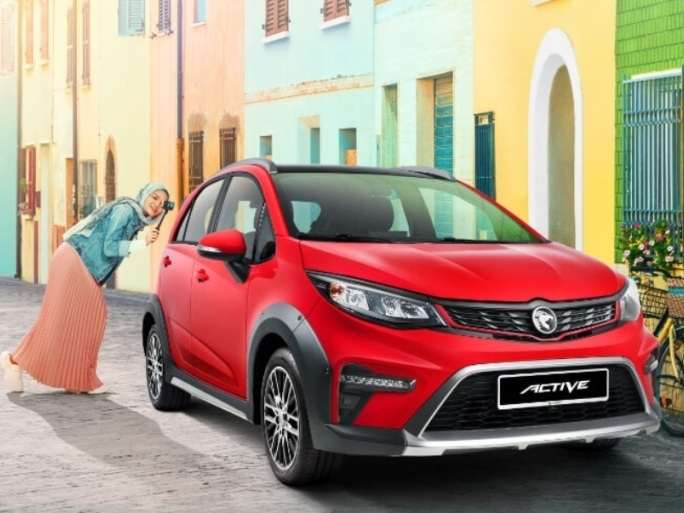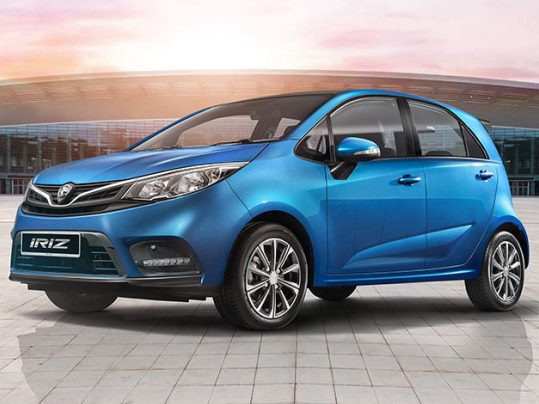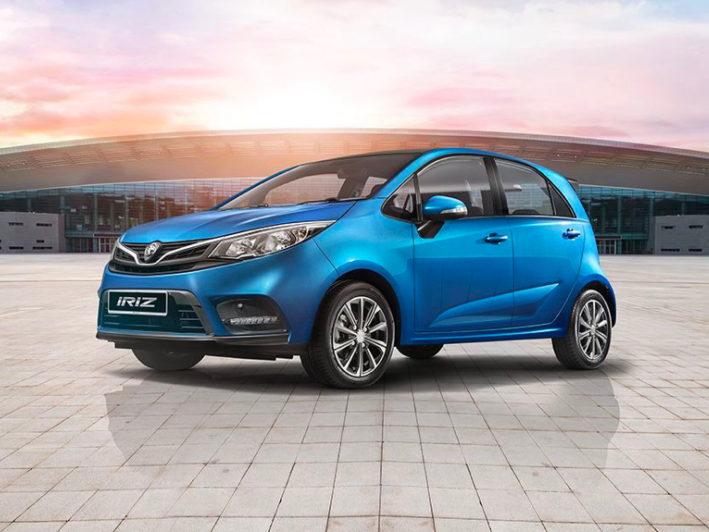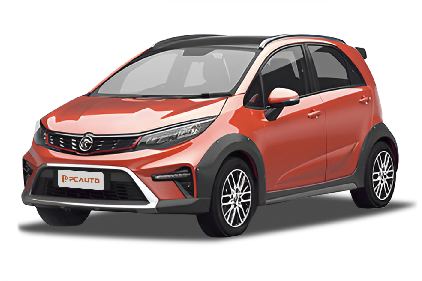Q
What is the top speed of Iriz?
The top speed of Iriz varies by configurations equipped by different models. Typically, the Proton Iriz can achieve a top speed of 182 km/h. However, the actual top speed may be influenced by multiple factors including road conditions, weather conditions, and vehicle load.
For driving safety, drivers must strictly adhere to traffic regulations and speed limits, avoiding any unnecessary pursuit of excessive speeds. Furthermore, regular vehicle maintenance helps sustain optimal performance.
Special Disclaimer: This content is published by users and does not represent the views or position of PCauto.
Related Q&A
Q
What is the fuel consumption of 2021 Proton Iriz?
The fuel efficiency of the 2021 Proton Iriz varies by engine configuration. Models equipped with the 1.3-liter VVT engine deliver an average combined fuel consumption of around 5.6 liters per 100 kilometers, while the 1.6-liter VVT version comes in at approximately 5.8 liters per 100 kilometers. Actual fuel usage may fluctuate slightly depending on driving habits, road conditions, and vehicle maintenance status. This car features Proton's Efficient Dynamics technology, including lightweight body design and low-rolling-resistance tires, which help improve fuel economy. For Malaysian consumers, the Iriz's fuel efficiency ranks above average among its class of hatchbacks, making it suitable for city commuting. To further reduce fuel consumption, it's advisable to maintain a steady speed, avoid sudden acceleration and hard braking, and regularly replace the air filter and spark plugs. It's worth noting that fuel efficiency test data is typically based on ideal laboratory conditions, and real-world driving may vary due to factors like weather and traffic conditions. Therefore, owners can track their actual fuel consumption under personal driving conditions by recording fuel refills and mileage driven.
Q
What is the fuel consumption per 100km of Proton Iriz?
The official combined fuel consumption figures for different versions of the Proton Iriz show some variation. The 1.3-liter version has an official combined fuel consumption of 6.6 to 6.9 L/100km, while the 1.6-liter version ranges from 7.4 to 8.36 L/100km. However, the actual fuel consumption of a vehicle may fluctuate due to factors such as driving habits, road conditions, and vehicle load.
For instance, aggressive acceleration, hard braking, and frequent stop-and-go driving can lead to increased fuel consumption. Additionally, driving for extended periods in congested conditions, where the engine is idling or operating at low speeds, can also cause fuel efficiency to drop. Excessive vehicle load, such as carrying numerous items or a full passenger capacity, similarly results in greater fuel usage.
Understanding these influencing factors can help drivers maintain good driving habits and manage vehicle load effectively, thereby reducing actual fuel consumption.
Q
What are the fuel consumptions of Iriz and Persona?
The fuel consumptions of Proton Iriz and Persona primarily depend on engine configuration and driving conditions, though official test data provides general reference ranges.
The Iriz is equipped with 1.3L and 1.6L VVT naturally aspirated engines. The 1.3L manual variant achieves approximately 14 km/L (city) to 18 km/L (highway) under standard test conditions, with the automatic version being 1-2 km/L lower. The 1.6L version consumes about 10% more fuel.
The Persona is equipped with a 1.6L engine, delivering combined fuel economy of about 15-16 km/L for manual transmission and 14-15 km/L for CVT variants. Its heavier body results in slightly lower fuel efficiency compared to the Iriz.
In real-world driving, fuel consumption may worsen by 20% in heavy traffic conditions, while steady-speed cruising on highways like the North-South Expressway may approach official figures.
Owners are advised to maintain proper tire pressure (190-210 kPa), avoid aggressive acceleration, and utilize cruise control to optimize fuel economy. These models deliver average fuel efficiency for their class in Malaysia, with regular maintenance (including throttle body cleaning and spark plug replacement) being crucial for sustaining optimal performance.
Q
What is the fuel consumption of Iriz 2018?
The fuel consumption of the 2018 Proton Iriz varies depending on engine and transmission configurations. The 1.3L manual version has a combined fuel economy of approximately 5.5L/100km (about 18.2km/L), while the 1.3L CVT automatic version averages around 5.9L/100km (about 17km/L). As for the 1.6L engine variants, the manual transmission model consumes about 6.1L/100km (approximately 16.4km/L), with the CVT automatic version at roughly 6.5L/100km (about 15.4km/L).
Actual driving fuel efficiency is influenced by multiple factors, including traffic conditions (such as higher consumption in congested Kuala Lumpur urban areas), driving habits (aggressive acceleration or high-speed driving increases fuel usage), and vehicle maintenance condition (cleanliness of air filters and spark plugs, proper tire pressure).
To optimize fuel economy, we recommend maintaining smooth throttle control, utilizing Eco mode (if equipped), and performing regular maintenance. Proper driving techniques can help your Iriz achieve closer-to-official fuel consumption figures while also extending its engine lifespan.
Q
What's the color of Proton Iriz?
The Proton Iriz offers a variety of color options in Malaysia, including standard colors such as Snow White, Silver, Graphite Grey, Ruby Red, and Marine Blue. Some variants even have the combination of two colors, like Solid Black paired with Pearl White. All paints utilize high-quality coatings designed for Malaysia's hot and humid climate, ensuring long-term color retention without fading.
When selecting a color, buyers may consider not only personal preference but also factors like resale value and maintenance costs. Lighter colors such as white and silver are popular choices in Malaysia as they absorb less heat during summer months and show minor scratches less noticeably. Meanwhile, darker colors like black or red offer a more dynamic appearance but are more sensitive to sun exposure and dust.
Q
Is Iriz equipped with a turbocharged engine?
The Proton Iriz is not available with a turbocharged engine option, as the entire lineup is equipped with naturally aspirated engines with either 1.3L or 1.6L displacement. While the Iriz lacks turbocharging technology, its engines perform well in fuel efficiency and daily urban driving. The linear power output of these naturally aspirated engines is particularly suitable for Malaysia's frequent stop-and-go traffic conditions.
For consumers seeking more powerful performance, Proton offers other models like the X50 or X70, both equipped with 1.5L turbocharged engines that provide stronger acceleration. Proton has not announced any plans to introduce a turbocharged version of the Iriz, but any future developments would typically be released through official channels.
For budget-conscious owners prioritizing practicality, the naturally aspirated Iriz is an attractive choice, offering advantages in maintenance costs and fuel efficiency.
Q
What are the different variants of Iriz?
The Proton Iriz is available in multiple variants. In engine displacement, there are 1.3L and 1.6L options.
The 2023 Proton Iriz 1.3 Standard CVT is priced at RM 42,800 with an official combined fuel consumption of 6.9L/100km and a maximum engine output of 95PS.
The 2023 lineup also includes two 1.6L versions: the 1.6 Executive CVT and 1.6 Active CVT, priced at RM 50,300 and RM 57,300 respectively. Both are equipped with a 109PS engine with official combined fuel economy of 7.4L/100km.
These variants differ in configurations. For example, the 1.3 Standard CVT provides 4 airbags, while both 1.6L versions offer 6 airbags. Additional features are also different - the 1.6 Active CVT includes voice-controlled air conditioning, while some models are equipped with front parking sensors and reverse cameras. Buyers can choose according to their budget and requirements.
Q
What is the safety rating of Proton Iriz?
The Proton Iriz achieved an impressive 5-star safety rating in the 2014 ASEAN New Car Assessment Program (ASEAN NCAP) testing - a remarkable accomplishment for a B-segment hatchback. This rating shows the Iriz's high standards in body structure rigidity, crash protection, and active/passive safety features. The model is equipped with key safety technologies including dual airbags (upgraded to six airbags in higher trims), ABS anti-lock braking system, EBD electronic brake-force distribution, and ESC electronic stability control.
Notably, the Iriz scored 14.93 out of 16 points in adult occupant protection and 42.45 out of 49 points in child occupant protection - outstanding results in its vehicle class that make it particularly suitable for safety-conscious consumers in Malaysia. While the 2023 model hasn't undergone renewed testing, subsequent Proton models like the X50 and X70 have maintained these high safety standards, proving the brand's persistent commitment to safety performance.
For budget-minded consumers in Malaysia seeking premium safety features, the Iriz is a popular choice.
Q
What type of engine is the Proton Iriz equipped with?
The Proton Iriz mainly adopts naturally aspirated engines, available in 1.3L and 1.6L displacements.
The 1.3L engine has a displacement of 1,332 mL, delivering maximum power of 95 PS (70 kW) at 5,750 rpm and peak torque of 120 N·m at 4,000 rpm, with an inline 4-cylinder configuration.
The 1.6L engine features 1,597 mL displacement, producing 109 PS (80 kW) maximum power at 5,750 rpm and 150 N·m peak torque at 4,000 rpm, also in an inline 4-cylinder arrangement.
These two engine options cater to different driver needs - the smaller displacement suits economical daily driving, while the larger engine provides enhanced performance for power-oriented drivers.
Q
What is the fuel consumption of the Iriz 1.3 manual transmission?
The Iriz 1.3 manual transmission model, officially named the 2019 Proton Iriz 1.3 VVT Standard MT, has an official combined fuel consumption of 6.7L/100km. This B-segment vehicle measures 3,945mm in length, 1,722mm in width, and 1,554mm in height, with a wheelbase of 2,555mm and a curb weight of 1,132kg. It is equipped with a naturally aspirated 4-cylinder engine delivering maximum power of 95PS (70kW).
Its front suspension features MacPherson struts, complemented by ventilated disc brakes. It runs on 175/65 R14 tires all around. Safety features include ABS anti-lock braking and electronic stability control. The cabin offers mostly manual-adjustment seats and a single-zone manual air conditioning system. Understanding these specifications will help you better know this model's fuel efficiency and overall performance.
Popular Cars
Model Year
Car Compare
Car Photo
Latest Q&A
Q
How much does it cost to buy a 2024 Tesla Model 3?
The 2024 Tesla Model 3 starts at around RM 175,000, but the final price depends on your chosen configuration and add-ons. Opt for the Long Range or Performance version, and you’re looking at a higher tag.
As Tesla’s entry-level model, it packs cutting-edge EV tech, including 500+ km of range on a single charge and standard Autopilot for both daily commutes and road trips. Just keep in mind extra costs like insurance, registration, and potential home charger installation.
Tesla’s Supercharger network is expanding locally, with solid coverage in major cities, making charging hassle-free. Maintenance costs? Typically lower than gas cars—no oil changes, fewer moving parts—so long-term savings add up.
If you’re after more thrills, the Performance variant hits 0-100 km/h in roughly 3 seconds. Plus, government EV tax perks help soften the upfront cost.
Q
How reliable is the 2024 Model 3?
The 2024 Model 3 delivers solid reliability, thanks to Tesla’s continuous software updates and hardware refinements. Key areas like the battery management system and Autopilot have seen multiple optimizations, leading to a noticeable drop in failure rates.
This model features a stiffer body structure and an improved suspension setup, offering a smoother ride. Upgraded interior materials also help reduce cabin rattles—a common gripe with earlier builds.
EV maintenance costs remain low (no oil changes, etc.), though it’s wise to periodically check battery health and charging components for long-term performance. For shoppers eyeing EVs, charging infrastructure and home charging options matter—thankfully, public chargers are expanding fast, making daily use more convenient.
If you frequently road-trip, planning charging stops ahead helps. While the range easily handles daily drives, a little route prep goes a long way in maximizing the experience.
Q
What is the battery range of the Tesla Model 3 2025?
The battery range of Tesla Model 3 2025 is expected to be optimized based on existing models, and specific data needs to be released officially. However, referring to the EPA range of the 2024 rear wheel drive version, which is about 438 kilometers, and the high-performance version, which is about 513 kilometers, the 2025 model may further improve, especially in terms of battery technology or energy efficiency management. For electric vehicles, the range is greatly affected by driving habits, road conditions, and climate. Air conditioning may slightly reduce the range in hot weather, but the battery thermal management system can usually maintain stable performance. In terms of charging, Model 3 supports super fast charging, which can replenish about 250 kilometers of range in about 15 minutes, while home charging stations require 6-8 hours to fully charge. Daily commuting or long-distance travel are practical enough, it is recommended to follow Tesla's official website or local showroom for the latest information.
Q
Is the 2024 Model 3 worth the price?
The 2024 Model 3 strikes an impressive balance between price and performance. Its upgraded range, more refined interior, and enhanced autonomous driving features genuinely boost its competitiveness—especially for tech-savvy, eco-conscious buyers.
Tesla optimized the battery efficiency this time around, making it suitable for both daily commutes and longer trips, while the handling stays true to the brand’s signature responsiveness. If your budget allows and you’re open to EVs, this one’s worth considering—though a test drive is wise to see if it matches your driving style.
That said, local charging access matters. While public chargers are becoming more common, home installation costs should factor into your budget. Alternatives in this price range exist, so cross-shop specs and service policies (like warranty coverage or charging network support) to make a well-rounded decision.
Q
How many miles does a 2024 Tesla Model 3 get?
The 2024 Tesla Model 3 offers varying range figures depending on configuration. The rear-wheel-drive (RWD) version delivers an EPA-estimated 272 miles (approx. 438 km), while the all-wheel-drive Long Range model pushes that to around 341 miles (roughly 549 km). Real-world range may vary slightly based on driving style, road conditions, and climate.
As a pure EV, the Model 3 achieves this efficiency thanks to its advanced battery management system and lightweight design. It also supports fast charging—at a Tesla Supercharger, you can add up to 200 km of range in about 15 minutes. Whether for daily commutes or longer trips, that’s more than enough for most drivers, especially with charging infrastructure becoming more widespread.
If you need to maximize range, tweaking your driving mode or using the car’s built-in energy optimization features can help squeeze out even more miles.
View MoreRelated News

Perodua Myvi's competitor Proton Iriz officially discontinued, ending its 11-year sales journey
JohnSep 11, 2025

Proton Iriz Interior Design Revealed: Economical and Well-Equipped
RobertJul 24, 2025

Proton Iriz Buying Guide: Captivating Consumers with Stylish Design and Abundant Features
LienApr 21, 2025

The Proton Iriz starts at RM 42,800, with two engines, both paired with a CVT gearbox.
LienJun 20, 2024

Proton Persona will be discontinued in 2026, with total sales exceeding 450,000 units
RobertDec 10, 2025
View More

















Pros
Cons